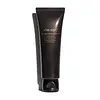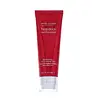What's inside
What's inside
 Key Ingredients
Key Ingredients

 Benefits
Benefits

 Concerns
Concerns

 Ingredients Side-by-side
Ingredients Side-by-side

Myristic Acid
CleansingGlycerin
HumectantStearic Acid
CleansingPotassium Hydroxide
BufferingSorbitol
HumectantDipropylene Glycol
HumectantLauric Acid
CleansingPEG-20 Glyceryl Isostearate
PEG-6
HumectantPEG-32
HumectantSodium Methyl Cocoyl Taurate
CleansingGlyceryl Stearate Se
EmulsifyingGlycol Distearate
EmollientPolyquaternium-7
Parfum
MaskingTrisodium EDTA
Sodium Methyltaurate
Skin ConditioningButylene Glycol
HumectantLinalool
PerfumingCitronellol
PerfumingGeraniol
PerfumingButylphenyl Methylpropional
PerfumingSodium Metabisulfite
AntioxidantPrunus Speciosa Leaf Extract
Skin ConditioningCI 77492
Cosmetic ColorantCI 77491
Cosmetic ColorantMyristic Acid, Glycerin, Stearic Acid, Potassium Hydroxide, Sorbitol, Dipropylene Glycol, Lauric Acid, PEG-20 Glyceryl Isostearate, PEG-6, PEG-32, Sodium Methyl Cocoyl Taurate, Glyceryl Stearate Se, Glycol Distearate, Polyquaternium-7, Parfum, Trisodium EDTA, Sodium Methyltaurate, Butylene Glycol, Linalool, Citronellol, Geraniol, Butylphenyl Methylpropional, Sodium Metabisulfite, Prunus Speciosa Leaf Extract, CI 77492, CI 77491
Water
Skin ConditioningMyristic Acid
CleansingGlycerin
HumectantBehenic Acid
CleansingPalmitic Acid
EmollientPotassium Hydroxide
BufferingSodium Methyl Cocoyl Taurate
CleansingLauric Acid
CleansingStearic Acid
CleansingSerenoa Serrulata Fruit Extract
Skin ConditioningLycium Chinense Fruit Extract
AntioxidantVaccinium Macrocarpon Fruit Extract
AstringentVaccinium Angustifolium Fruit Extract
Skin ProtectingSaccharomyces Lysate Extract
HumectantOryza Sativa Bran Extract
Skin ConditioningPunica Granatum Fruit Juice
MaskingYeast Extract
Skin ConditioningCaffeine
Skin ConditioningDipotassium Glycyrrhizate
HumectantPolyquaternium-7
Montmorillonite
AbsorbentCreatine
Skin ConditioningPolyquaternium-51
Skin ConditioningPEG-3 Distearate
EmulsifyingSodium PCA
HumectantUrea
BufferingSodium Hyaluronate
HumectantTrehalose
HumectantButylene Glycol
HumectantParfum
MaskingTocopheryl Acetate
AntioxidantDisodium EDTA
BHT
AntioxidantMethylchloroisothiazolinone
PreservativeMethylisothiazolinone
PreservativePhenoxyethanol
PreservativeCI 19140
Cosmetic ColorantCI 14700
Cosmetic ColorantWater, Myristic Acid, Glycerin, Behenic Acid, Palmitic Acid, Potassium Hydroxide, Sodium Methyl Cocoyl Taurate, Lauric Acid, Stearic Acid, Serenoa Serrulata Fruit Extract, Lycium Chinense Fruit Extract, Vaccinium Macrocarpon Fruit Extract, Vaccinium Angustifolium Fruit Extract, Saccharomyces Lysate Extract, Oryza Sativa Bran Extract, Punica Granatum Fruit Juice, Yeast Extract, Caffeine, Dipotassium Glycyrrhizate, Polyquaternium-7, Montmorillonite, Creatine, Polyquaternium-51, PEG-3 Distearate, Sodium PCA, Urea, Sodium Hyaluronate, Trehalose, Butylene Glycol, Parfum, Tocopheryl Acetate, Disodium EDTA, BHT, Methylchloroisothiazolinone, Methylisothiazolinone, Phenoxyethanol, CI 19140, CI 14700
Ingredients Explained
These ingredients are found in both products.
Ingredients higher up in an ingredient list are typically present in a larger amount.
Butylene Glycol (or BG) is used within cosmetic products for a few different reasons:
Overall, Butylene Glycol is a safe and well-rounded ingredient that works well with other ingredients.
Though this ingredient works well with most skin types, some people with sensitive skin may experience a reaction such as allergic rashes, closed comedones, or itchiness.
Learn more about Butylene GlycolGlycerin is already naturally found in your skin. It helps moisturize and protect your skin.
A study from 2016 found glycerin to be more effective as a humectant than AHAs and hyaluronic acid.
As a humectant, it helps the skin stay hydrated by pulling moisture to your skin. The low molecular weight of glycerin allows it to pull moisture into the deeper layers of your skin.
Hydrated skin improves your skin barrier; Your skin barrier helps protect against irritants and bacteria.
Glycerin has also been found to have antimicrobial and antiviral properties. Due to these properties, glycerin is often used in wound and burn treatments.
In cosmetics, glycerin is usually derived from plants such as soybean or palm. However, it can also be sourced from animals, such as tallow or animal fat.
This ingredient is organic, colorless, odorless, and non-toxic.
Glycerin is the name for this ingredient in American English. British English uses Glycerol/Glycerine.
Learn more about GlycerinLauric Acid is a fatty acid or lipid. About half of fatty acids in coconut oil is lauric acid.
This ingredient helps hydrate and sooth skin. As a humectant, it helps trap moisture. It also aids in cleaning and enhancing the texture of products.
Lauric acid may not be Malassezia folliculitis, or fungal acne, safe.
Learn more about Lauric AcidMyristic Acid is a saturated fatty acid. It is naturally found in milk fat. Other sources include palm oil, coconut oil, and butter fat.
Myristic Acid is an emulsifer and cleanser. As an emulsifer, it stabilizes a product by preventing ingredients from separating. Myristic Acid helps clean your skin by acting as a surfactant. It tends to gather oil and dirt on your skin to be easily rinsed away.
One study from 2021 found Myristic Acid to have anti-inflammatory properties.
Learn more about Myristic AcidParfum is a catch-all term for an ingredient or more that is used to give a scent to products.
Also called "fragrance", this ingredient can be a blend of hundreds of chemicals or plant oils. This means every product with "fragrance" or "parfum" in the ingredients list is a different mixture.
For instance, Habanolide is a proprietary trade name for a specific aroma chemical. When used as a fragrance ingredient in cosmetics, most aroma chemicals fall under the broad labeling category of “FRAGRANCE” or “PARFUM” according to EU and US regulations.
The term 'parfum' or 'fragrance' is not regulated in many countries. In many cases, it is up to the brand to define this term.
For instance, many brands choose to label themselves as "fragrance-free" because they are not using synthetic fragrances. However, their products may still contain ingredients such as essential oils that are considered a fragrance by INCI standards.
One example is Calendula flower extract. Calendula is an essential oil that still imparts a scent or 'fragrance'.
Depending on the blend, the ingredients in the mixture can cause allergies and sensitivities on the skin. Some ingredients that are known EU allergens include linalool and citronellol.
Parfum can also be used to mask or cover an unpleasant scent.
The bottom line is: not all fragrances/parfum/ingredients are created equally. If you are worried about fragrances, we recommend taking a closer look at an ingredient. And of course, we always recommend speaking with a professional.
Learn more about ParfumPolyquaternium-7 is a light to clear colored liquid. It is commonly found in haircare products for its film-forming and anti-static properties.
According to a manufacturer, it is a non-paraben and specially developed for negatively charged surfactant systems. This makes it a great hairstyle holder and helps to improve wet hair detangling without adding buildup.
Potassium hydroxide is commonly known as caustic potash. It is used to fix the pH of a product or as a cleaning agent in soap. In cleansers, it is used for the saponification of oils.
Sapnification is the process of creating fatty acid metal salts from triglycerides and a strong base. During this process, Potassium Hydroxide is used up and is not present in the final product.
Using high concentrations of Potassium Hydroxide have shown to irritate the skin.
Learn more about Potassium HydroxideThis gentle cleansing and foaming ingredient is known for leaving a smooth feeling in skin and hair. It is made using coconut oil.
According to the manufacturer, it is soluble in water and has resistance to hard water, acid, and alkali.
Due to its coconut base, it may not be Malassezia folliculitis safe.
Learn more about Sodium Methyl Cocoyl TaurateStearic Acid is a fatty acid. It is an emollient, emulsifier, and texture enhancer.
As an emollient, stearic acid helps soften skin. It aids the skin's protective barrier by preventing water loss. It also provides a gentle cleansing effect without stripping away natural oils.
Stearic acid may also be used to enhance the texture of products. It can add volume and stabilize ingredients such as water and oil. This can help water and oil ingredients from separating.
Sources of stearic acid include animal or vegetable fats/oils such as coconut or shea. It can be naturally found in butter, cocoa butter, shea butter, vegetable fats, and animal tallow.
This ingredient may not be Malassezia folliculitis, or fungal-acne safe.
Learn more about Stearic Acid